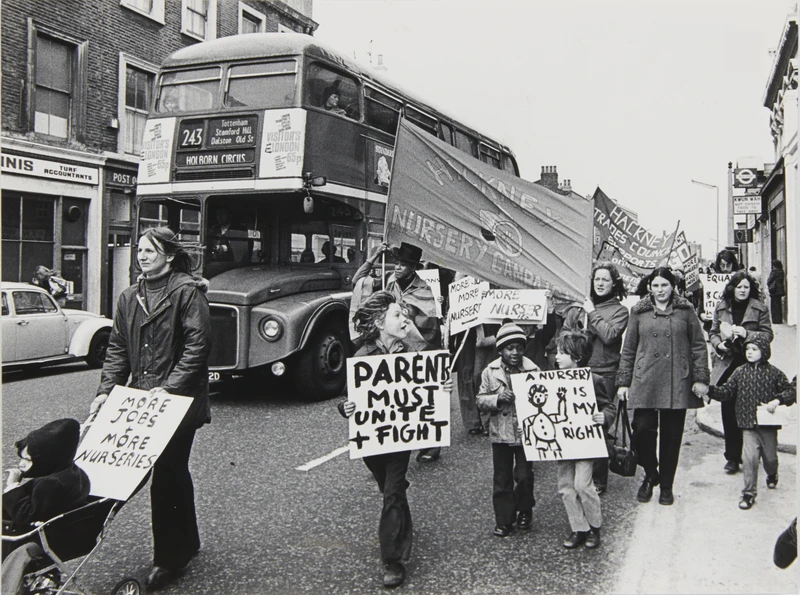we are a group of people composed of who we are
23 Jun-9 Sep 2023
PV 22 Jun 2023, 6.30-8.30pm


we are a group of people composed of who we are, traces artistic, cultural and social collective work that took place in Hackney between 1971 and 1986. Bringing together new commissions, existing artwork, literature, film and archival material, the exhibition and accompanying events programme explores the radical, influential and often entwined histories of cooperative and collective work in the borough. Examining how social and political commitments were supported by an engagement with art, literature and culture, the exhibition focuses on the complexities of collective work, and questions how we might learn from the past in order to reimagine our futures.
Taking 1971 as a starting point, the year that Centerprise cooperative opened in Dalston, and ending in 1986, the year the Greater London Council was dissolved, the exhibition maps a moment in time when collective work was being tested. Aiming to combat oppression and inequality, this work was often led by Hackney’s migrant communities, artists, socialists, and working-class east Londoners.
Centerprise’s long-term home was on Kingsland Rd in Dalston, but its origins came from Hoxton Café Project, a youth project and cafe located just a stone’s throw away from Peer’s home on Hoxton Street. When Hoxton Café Project closed in 1969, two ex-employees, Margaret Gosley and Glenn Thompson, envisioned a new space to support and sustain self-determined access to learning, culture and services for working-class people in the area. In 1971 Centerprise was founded with the principle that “the arts, youth and community work, social work and education itself, are not separate entities invariably requiring separate institutions. They are related and interdependent”. Alongside a bookshop and café, the space ran various youth activities such as chess clubs, drama and art classes, a reading and writing project, as well as legal advice and childcare facilities.
we are a group of people composed of who we are includes archival material relating to Centerprise’s early years, alongside material from various associated local initiatives such as the Lenthall Road Workshop, Free Form, Hackney Peoples Press, Hackney Campaign for Nuclear Disarmament, Hackney Writers Workshop, Hackney Under Fives Zine, Hackney Gutter Press, East London Anti-Fascist and Anti-Racist News and Hackney Unemployed Media Scheme, all displayed in custom-made tables that act as sites for congregation and conversation, as well as study. Works included in the exhibition by artists such as Ingrid Pollard, Neil Martinson, Jo Spence and the Hackney Flashers, Dan Jones and Maggie Murray, have been developed both collaboratively and individually, and their work is also represented in the ephemera included in the exhibition’s vitrines.
New commissions by artists Jacob V Joyce and Rudy Loewe occupy both the outside and inside of the gallery. Building on their research on civic space as a site for storytelling and activism, Joyce’s mural uses the motif of a stained-glass window to bring a sharp focus to narratives, people and imagery related to the exhibition. In the exhibition space, Loewe visually traces the interdependencies and solidarities between some of the collectives, campaigns and artists included in the exhibition, disrupting a linear reading of history and personal experience.
By no means exhaustive, this exhibition aims to chart some of the collectively made and politically driven work that was taking place in the borough between 1971 and 1986. Using artistic expression as a tool for social change the materials share a desire for access to better education, cultural production, childcare, housing, welfare and working conditions, alongside a commitment to anti-fascist organising and resistance to police corruption and brutality. Developed during the rise of neoliberalism in the late 1970s and early 1980s, as well as the brutal effects of Margaret Thatcher’s Conservative governments, many artists and collectives included in this exhibition were able to develop their work because of the support given by the radical GLC until its abolition by central government in 1986, which provided material and resources for self-organised cultural production.
we are a group of people composed of who we are explores the conditions for grassroots cultural and collective work from a diverse range of generations and backgrounds. In doing so, it asks: what can be learnt from these examples? and what does this history say about the conditions for collective and community-led cultural practice now?
we are a group of people composed of who we are is part of Peer’s programme for 2023, which explores themes of collective work, interdependency, and place, comprising exhibitions and new commissions by artists Tanoa Sasraku, Iris Touliatou and Leah Clements.
A series of events and workshops take place throughout the exhibition.